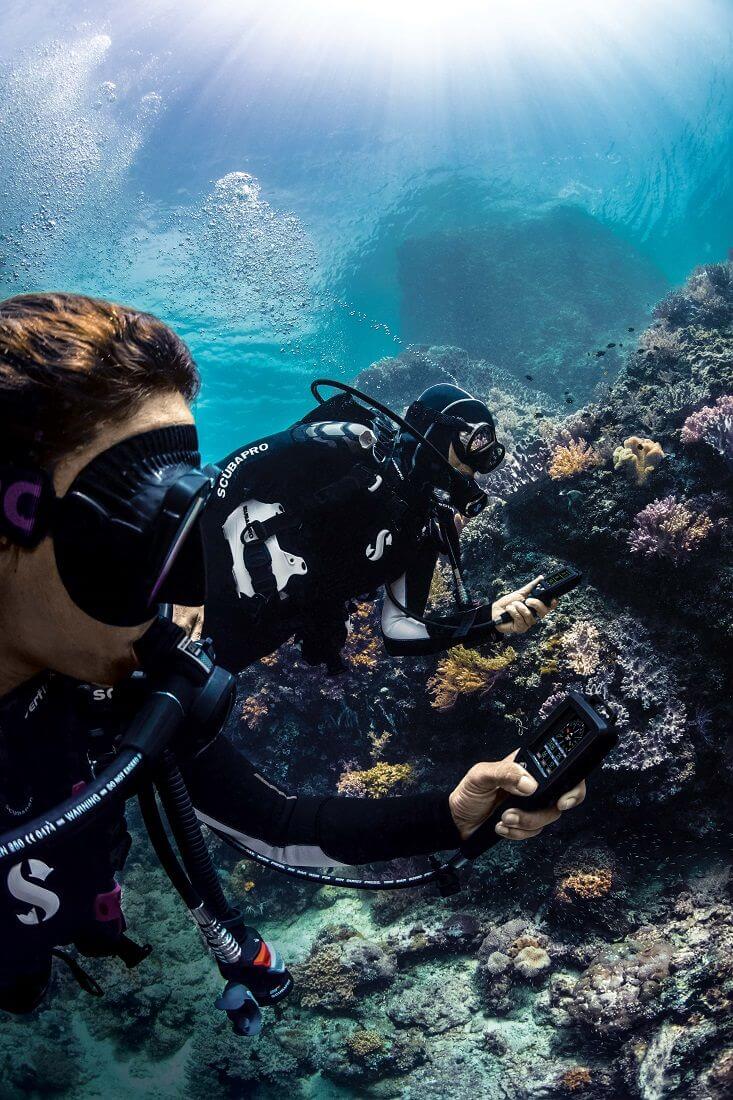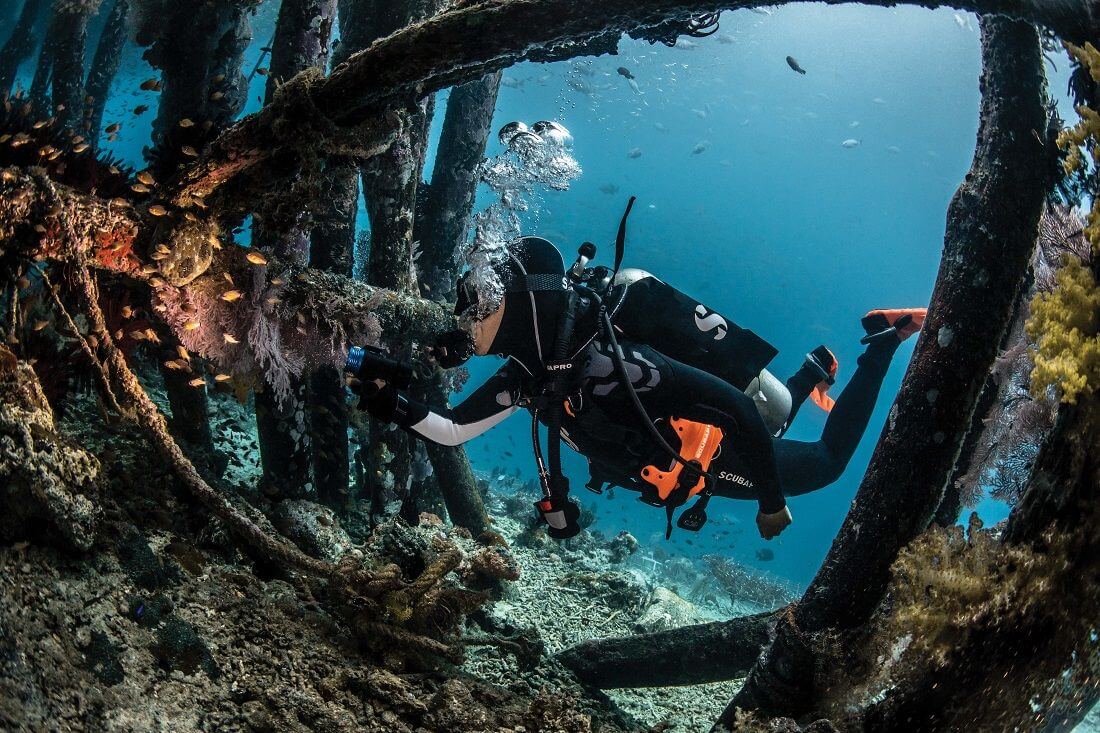Mastering Underwater Navigation
If you have ever gotten turned around on a dive site, couldn’t find your way back to an anchor line, or lost a piece of gear while diving, it may be time to work on your underwater navigation skills. Underwater navigation is a useful skillset that all divers can benefit from.
You probably understand the basics of a compass and its usage in straight line navigation, but practical application can be a little more involved than just shooting a bearing, twisting your bezel, and counting kick cycles while keeping the north arrow aligned with the index mark. It is as much about habit patterns, situational awareness, and a touch art, as it is about familiarity with your compass.
Choose an Idyllic Underwater Compass
The first step in mastering underwater navigation is owning a compass, and getting in the habit of diving with it. Much like your other dive gear, your compass offers no help sitting on the surface. The compass remains the basis for creating a physical or mental map of a dive site, or adapting to changing conditions such as current, changing bottom contours, or altered landmarks (as can happen when major storms hit). Eventually, you should be able to navigate your favorite dive sites without even using the compass, based on your knowledge of the site and natural navigation. But until then, or for all the new dive locations you’ll hit, check out all the dive compasses SCUBAPRO has to offer.

After familiarizing yourself with your compass, we recommend enrolling in an Underwater Navigation specialty course. Then you can incorporate compass use and natural navigation into all of your dives with ease.
Mastering Underwater Navigation as a Shore Diver
When doing a shore dive, the brief should include the heading back to the beach. If you turn your back to the water and twist your compass’ bezel, so the north arrow is aligned with the main index mark, you have now created a heading, and should be able to make it back to the beach if you get disoriented, lose your buddy, or otherwise need to call the dive and surface away from the entry point. Second thing to note when entering from the shore are the conditions. Turn back around and watch the water. If there is a longshore current or rip current, incorporate those considerations into your dive plan and brief. In addition, you can make bearings to landmarks (or to significant cultural lighting if it’s a night dive) to better orient yourself once on the surface. You can also use that information to relocate the dive site in the future using triangulation.
Enhancing Your Navigation Skills as a Night Diver
When planning a night dive, use an already familiar site or dive the site during the day and note depths, bottom contours, ridges in the sand, current (although this may change) or surge, landmarks, and headings. These cues will be used to navigate the site and return to the entry/exit point. Set up sufficient lighting to assist divers returning to the boat/beach and each diver should carry at least two lights and a marker light. We also recommend a compass with a luminous face. Additionally, SCUBAPRO has developed a compass dive light for added visibility to improve night diving navigation. If the current on the site is predictable, currents can also be used as a tool for navigation. If the orientation of the dive site allows, swim into the current to start the dive, and then drift back to the exit point. If the current is perpendicular to the direction you plan to swim, then the current should be from the left on the way out, and the right on the way back, or vice versa.
Bettering Underwater Navigation as a Boat Diver
If you are diving off a boat that is moored or anchored, note the direction the bow is pointed before leaving the boat. Once on the line, take note of your heading when pointed into the current (it’s not unusual for these headings to differ). If you are diving a recreational profile, we suggest aligning the index mark with the north arrow when you are at a depth of twenty feet – where you will spend the most time during your ascent. While currents may change during a dive, this at least gives you a chance of minimizing the distance you drift down-current from the boat if you have to execute a free ascent. As you ascend and conduct your deep and safety stops, keep yourself oriented and kicking in that direction to minimize that drift. Best case, you may surface up-current of the boat, and worst-case, at least you have minimized the impending surface swim and/or are within visual range of the boat. Realize that this is a contingency plan and the best course of action is using the anchor/mooring line to return directly to the boat.

If you are live boating, a marker buoy is a great tool. This allows you to mark the site, and confirm the correct location of the buoy with your bottom machine before ever putting divers in the water. Descend with the line as a reference, and note your outbound heading from the line to facilitate returning to it. This will make you more predicable for your friends in the boat when it comes time for a pick-up. You’ll still want to be prepared to deploy your SMB from depth or on the surface, as necessary. Always keep an eye above you while at your safety stop and the final ascent - you don’t surface below the boat!
Perfecting Navigation as a Drift Diver
The above techniques work well when ascending from a drift dive. As long as the dive site is visible, we recommend to keep yourself over it, orienting into the current. Having noted your heading at that point, you will continue to reference your heading as you ascend, in order to minimize your downrange travel. If there are other boats on the site, however, you will need to allow yourself to drift downstream in order to surface away from boat traffic for your own safety and ease of pick-up for the boat captain. In this case, it is recommend to deploy your SMB from the safety stop to ensure the boat can follow you.
Honing Navigation Skills as a Wreckage Diver
While on the dive site, navigation depends on the nature of the site and prevailing conditions. Before you leave the line, take note of significant landmarks so you recognize the location once you return. Continue to note landmarks as you navigate the site. In general, your initial direction of travel should be into the current, if one is present, unless you are on a drift dive.
One of the easiest ways to navigate a small wreck is to keep the same shoulder toward the wreck as you circumnavigate it, and that will take you around the wreck and back to your tie-in point. You should note your initial heading on your compass, though, because as you start looking in nooks and crannies, photographing fish, and otherwise get distracted, you’ll want to know your general direction of travel so you can continue around the wreck. As well, wrecks that have been down for decades or centuries may be significantly broken up, and not provide enough visually significant checkpoints to navigate without knowing your original heading from the line. On a larger wreck or linear reef, you’ll swim up-current until you reach your turn point based on time or gas, and drift back to your exit point, letting the current do your work for you.
One point of caution – wrecks generally contain a significant amount of ferrous material. If you shoot these initial headings too close to the wreck, your compass north arrow will be pointing at the wreck instead of north, so take your base headings while on the line, well above the wreck.

Ways to Use Nature to Be Your Underwater Guide
Before we part ways...fish and shrimp, you ask? Absolutely. Anyone that fishes can tell you that fish love structures. You can use this as a natural aide to your navigation, too. If you pay attention, you’ll find that you can follow the “fish welcome committee” to a wreck or reef when the current or visibility have altered your descent. It doesn’t happen often, but absent of other cues, use the fish as your guide. We tend think of the underwater environment as a rather serene, quiet place; but a reef is not as peaceful as we think, and we can use that to our benefit.
Reefs are always hustling and bustling, something is always eating and the sound of creatures nibbling on their dinner makes for plenty of noise. While we can’t determine the actual direction of the sound, it can help you locate a shallow reef when the water is turbid enough to obscure the dive site from the surface. If it’s getting louder, you’re getting warmer and vice versa. This trick can be used on artificial reefs, located on otherwise flat, sandy bottoms, when recent rains or winds have stirred things up or an algae bloom has reduced visibility.
The Benefits of Mastering Underwater Navigation
This may all seem like a lot of work, but making these habits a part of your underwater skillset will – without a doubt – make your diving safer, and thus more rewarding. When you are intimately familiar with a site and can confidently navigate it, you’ll end up showing your buddies the local underwater residents, and they will be suitably impressed and thankful. You may also locate lost knives, lights and other equipment in lower visibility within minutes of other divers reporting their loss and earn yourself a grateful “thank you.”






